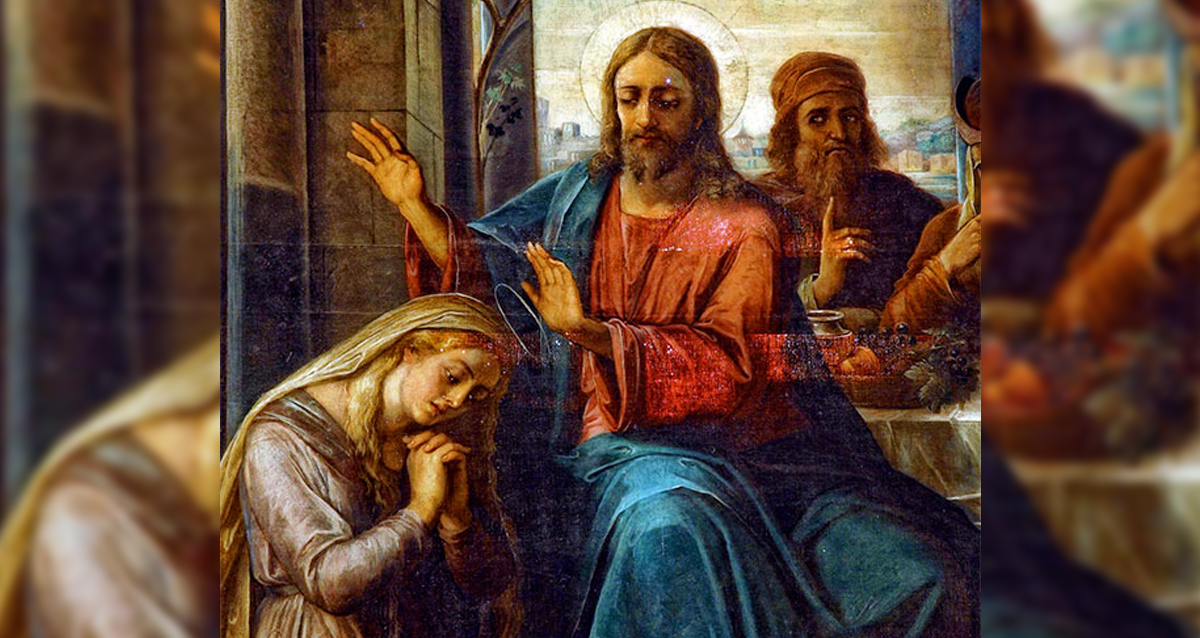The passionate soul does not know fear, it does not measure risks. In the Garden of Olives the Apostles fled in terror. Mary Magdalene, on the other hand, went out in search of her Beloved, and He went to meet her.
A sinner! For this and other unpleasant epithets were pointed out in Jerusalem and around to Mary Magdalene, a rich woman of noble lineage, remarkable beauty and dissolute life.
She had allowed herself to be dragged, still very young, by vanity, the first step in the elusive ramp that leads to the muddy waters of impurity. In that deplorable situation, she entered the Gospels with the nickname of public sinner: in civitate peccatrix, that is, a sinner known as such in the city (Lk 7, 37).
At a certain moment, however, her paths crossed with those of Jesus. The evangelists do not report where, when or how that first meeting occurred, but later on she starred in one of the best-known episodes of the New Testament: bringing an alabaster jar of ointment, burst into the dining room of Pharisee Simon, went straight to where the Master was, he watered his feet with abundant tears, wiped them with his hair, covered them with kisses and, finally, anointed them with the refined perfume (cf Lk 7, 36-50).
With hers tears she washed the filth of her faults
Exciting scene, without a doubt. But not for Simon and the other diners. They looked at her with stupor, though without the courage to manifest the censure that boiled in their hearts. “If he were a prophet, he would know who and what kind of woman is the one who is touching him, because she is a sinner” (Lk 7, 39), the Pharisee said to himself.
Obscured by bad faith and envy, he did not perceive the undeniable reality: whoever was there was not the sinner, but the saint! Yes, because such a demonstration of repentance and love could only come from a soul already firmly placed on the path of holiness. “With her tears she washed away the stains of sin. […] For to whom in the first place sin had kept her in coldness, then love made her burn energetically “, 1 comments Pope St. Gregory the Great.
From there came Magdalena out with a new nickname that resonates two thousand years ago in history: repentant sinner. And in the whole world she is venerated as a role model and patron of all those who wish to free themselves from the most terrible type of slavery, the sin.
However, Jesus himself gave him that day a more glorious title: for she loved much (Lk 7:47). And she shines in Heaven and on earth as the saint of passionate love and confidence full of audacity.
The passionate soul does not measure risks
Passionate love? But … is not passion always an evil? No. The passion will be good or bad, noble or vile, according to the object of love. According to St. Peter Julian Eymard, only passionate love is authentic love: “The Eucharist is the noblest aspiration of our heart: let us love it passionately! […] One does not love but he who feels within himself the passion of love “.2
The evangelist highlights an important detail: “After this,” that is, immediately after the moving episode narrated above, Jesus was “walking from city to city and from town to town, proclaiming and announcing the Good News of the Kingdom of God, accompanied by the Twelve, and by some women”, among them “Mary the Magdalene, from whom seven demons had come out “(Lk 8, 1-2).
And that’s how, the ex-demoniac among the Holy Women, becomes a disciple of Jesus. There is no doubt that she did not need the Teacher to say, “follow me” because her heart did not crave anything but accompany him everywhere, hear his words, see him and be seen by him, express in prolonged or fleeting exchange of glances her unlimited love.
The passionate soul does not know fear, it does not measure risks. In the Garden of Olives the Apostles fled in terror. Magdalena, on the contrary, went in search of her Beloved and accompanied him on the ascent to Calvary. She remained at the foot of the cross until the moment of consummatum est. She participated in the funeral procession and did not want to leave even when the disciples left after the huge slab was placed at the entrance of the tomb: “Mary the Magdalene and the other Mary were sitting there in front of the tomb” (Mt 27 , 61). In this regard, exclaims Saint Catherine of Siena: “Oh Magdalena, you were crazy with love! You no longer had your heart, for It was buried with your sweet Master. “3
And Jesus went to meet her
Finally, no matter how much it hurts, she was forced to leave. By the Gospel accounts we can well imagine what her soul dispositions were that night and the next day. She had bought perfumes to anoint that adored body again, and before the sunrise, she went to the tomb with two other Holy Women.
For the one who loves nothing is impossible: there they were on their way without even knowing how they would roll the heavy slab of the entrance. They found it open and empty! Magdalena ran to give the news to the Apostles. Pedro and Juan ran out, they confirmed the fact and … “they went home” (Jn 20, 10).
However, she stayed by the grave, crying. Notice the force of passion: Jesus had died, she still did not believe in the Resurrection; therefore, she was looking for a corpse.
While she was crying, she looked back at the tomb. Why look again if she already knew it was empty? Because the one who truly loves does not get tired of trying. “She looked for the one she had not found, she looked for him crying and, ignited in the fire of her love, she burned with desires of Him whom she thought had been taken away”. 4
Did she find him at the end? Much better than that, He went to meet her: – Woman, why are you crying? Who are you looking for? the Master asked in such a way that she did not recognize his voice. Taking him for the gardener, she implored distressed:
– Sir, if you have taken him, tell me where you have put him and I will pick him up. He replied with a single word, with an intonation that revealed his infinite love: “Mary!”. And she also had one word to answer: “Rabboni!”, Which means Master. There he was, alive. The one to whom she was looking for him dead!
I saw him again, her heart found, at last, rest.
“Without the clarity of that light, no light is light”
What she saw in that exchange of looks is only known to the angels and the saints of Heaven. Although we can imagine that in the eyes of Jesus she had contemplated, much more magnificent this time, the same light that had shone on the occasion of his first encounter with Him: lux Christi, light of divine grace, whose power of attraction did not resist .
In fiery words of love for the Blessed Virgin, Prof. Plinio Corrêa de Oliveira gives us a precise idea of the effect produced by that light on the soul of those who do not put obstacles in their way: “Oh my Mother, Mediatrix of all graces, in your light we will see the light. Mother, I prefer to become blind before to stop seeing your light, because to see it is to live.
In its clarity we contemplate all the lights, and without it no light shines. I will not consider life when it does not shine; and from life I will not want to have anything but the mind bathed in that light. “Oh light, I will follow you regardless: by valleys, mountains, deserts, islands; in the tortures, in the abandonments and forgetfulness; in persecutions and temptations, in misfortunes, in joys and triumphs. I will follow you in such a way that, even at the zenith of glory, I will not bother with it, because I will only worry about you. I have seen you and until Heaven I will not want anything else, because once I contemplated you “.5
That is the light that awakens in the soul of every authentic saint, the fire of passionate love for Our Lord Jesus Christ.
1 SAN GREGORIO MAGNO. Homiliæ in Evangelia. L. II, hom. 25, n.º 1; 10: PL 76, 1189; 1196.
2 SAN PEDRO JULIÁN EYMARD. A Divina Eucaristia. Escritos e sermões de São Pedro Julião Eymard. São Paulo: Loyola, 2002, v. I, p. 171.
3 SANTA CATALINA DE SIENA. Lettres de Sainte Catherine de Sienne. Lettre 229, a Soeur Agnès Donna. 2.ª ed. Paris: Poussielgue Frères, 1886, t. III, p. 311.
4 SAN GREGORIO MAGNO, op. cit., n.º 1, 1189.
5 CORRÊA DE OLIVEIRA, Plinio. Na vossa luz veremos a luz. In: Dr. Plinio. São Paulo. Año VII. N.º 80 (Noviembre,2004); p. 36.

